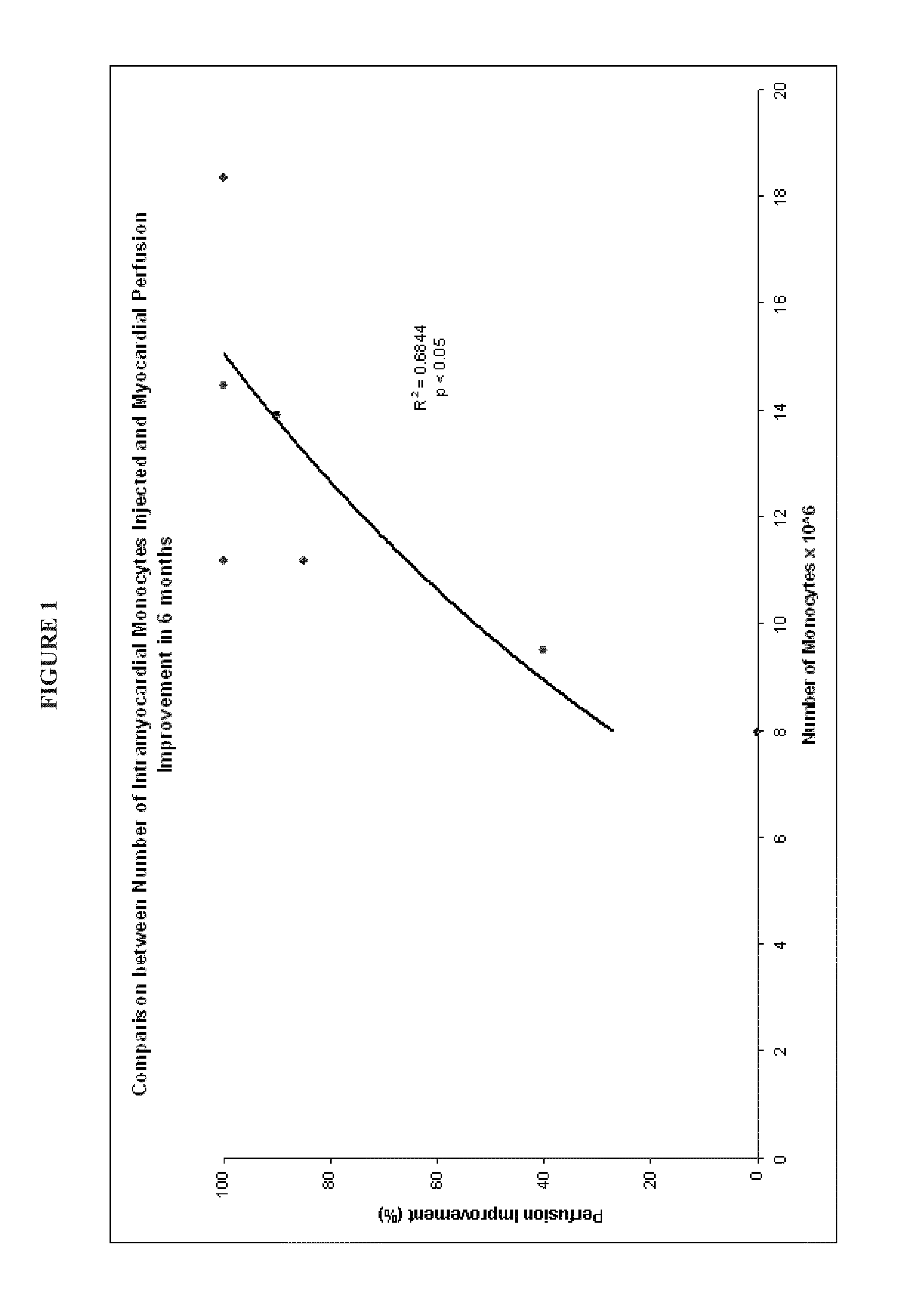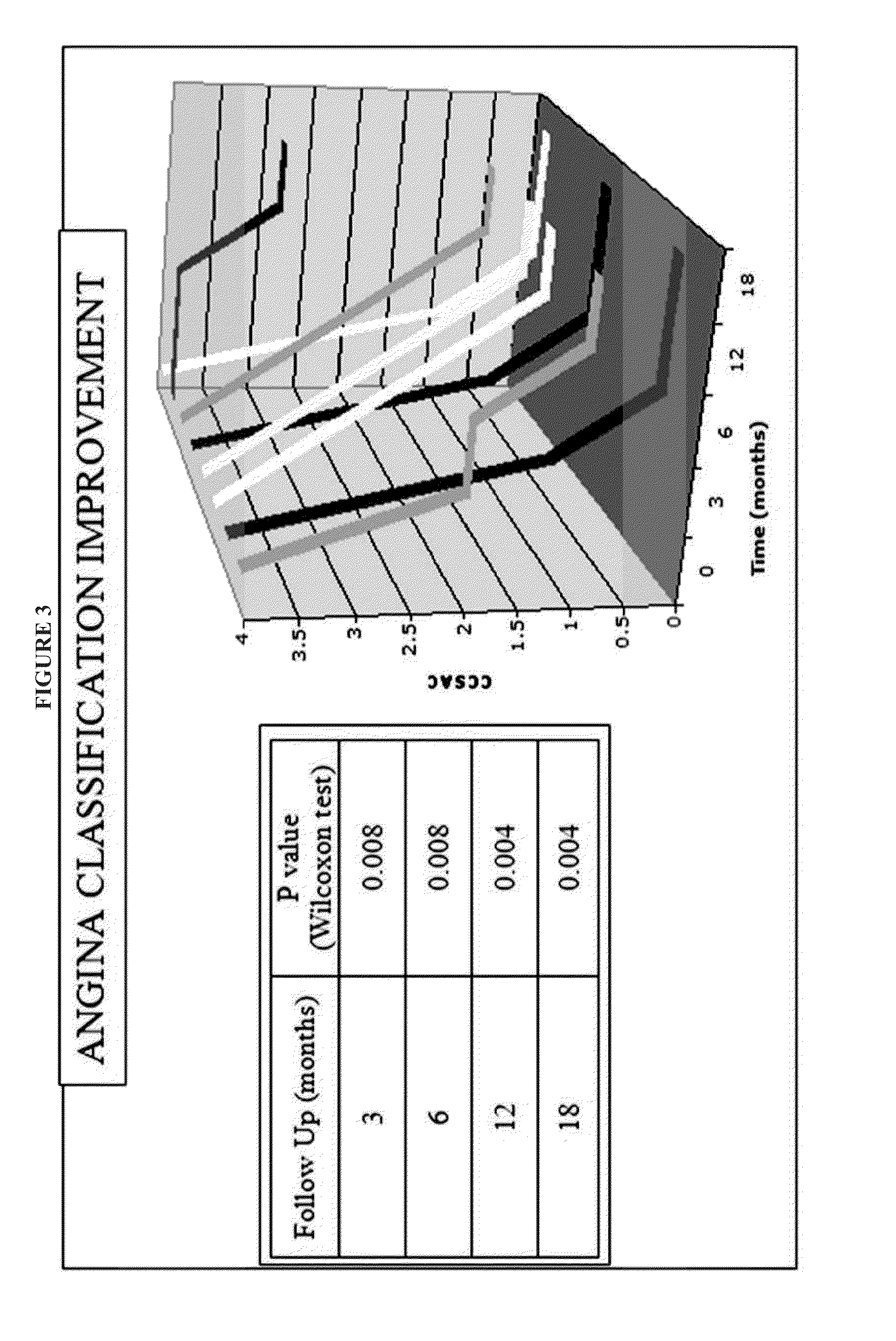Ischemic tissue cell therapy
a tissue cell and ischemic technology, applied in the direction of drug compositions, immunological disorders, metabolism disorders, etc., can solve the problems of inability to provide therapy to some angina patients, complex management of patients with refractory angina, and inability to demonstrate safety and efficacy of treatment, so as to improve the reliability of the effect of the
- Summary
- Abstract
- Description
- Claims
- Application Information
AI Technical Summary
Benefits of technology
Problems solved by technology
Method used
Image
Examples
example 1
Isolation of the Monocyte Lineage Cell Enriched Mononucleocyte Cell Population
[0101]The bone marrow mononucleocyte cell preparation was performed by standard density gradient (varying from 1.0 g / L to 1.1 g / L, preferably 1.077 g / L). The cell preparations as discussed in Example 2 below had different amounts of monocyte lineage cells.
[0102]The BMMC preparation was performed by density gradient separation with Ficoll Paque PREMIUM® (GE Healthcare). Bone marrow blood, 35 mL, was carefully added in 10 mL Ficoll per tube, without mixture, maintaining intact Ficoll surface tension. This procedure was repeated in 9 tubes, with for a total of 10 tubes / patient. The tubes were than centrifuged at 350 g—without brake, for 40 minutes, at 20° C. After density separation, the mononuclear ring (plasma / ficoll interface) was carefully collected from the 10 tubes and suspended in 4 tubes, with 0.9% saline solution added to result in 45 mL total tube volume. The 4 tubes were centrifuged at 400 g, for 1...
example 2
Correlation Between Number of Monocytes Injected Versus Therapeutic Outcome
[0103]The Example that follows presents data from patients treated using the methods and compositions set forth herein.
[0104]The aim of the study was to evaluate the safety and efficacy of a proprietarily designed protocol, the Refractory Angina Cell Therapy Protocol (ReACT), in which a single series of multiple intramyocardial injections of a specific BMMC formulation is performed as the sole surgical therapy for these patients.
[0105]ReACT was designed in compliance with Good Manufacturing Practices (GMP) and FDA standards criteria.
[0106]Patients enrolled in this protocol were required to have refractory angina pectoris, viable myocardium (diagnosed through stress tecnecium scintigraphy), without left ventricular dysfunction (ejection fraction of at least 45%) and not suitable for myocardial revascularization (either PTCA or CABG).
[0107]Eight refractory angina patients were included in the study from Septemb...
example 3
Monocytes for Brain Ischemia
[0206]Molecular Biology Techniques
[0207]Standard molecular biology techniques known in the art and not specifically described are generally followed as in Sambrook et al., Molecular Cloning: A Laboratory Manual, Cold Springs Harbor Laboratory, New York (1989, 1992), and in Ausubel et al., Current Protocols in Molecular Biology, John Wiley and Sons, Baltimore, Md. (1989). Polymerase chain reaction (PCR) is carried out generally as in PCR Protocols: A Guide to Methods and Applications, Academic Press, San Diego, Calif. (1990). Reactions and manipulations involving other nucleic acid techniques, unless stated otherwise, are performed as generally described in Sambrook et al., Molecular Cloning: A Laboratory Manual, Cold Springs Harbor Laboratory Press, and methodology as set forth in U.S. Pat. Nos. 4,666,828; 4,683,202; 4,801,531; 5,192,659; and 5,272,057 and incorporated herein by reference. In situ PCR in combination with Flow Cytometry can be used for det...
PUM
| Property | Measurement | Unit |
|---|---|---|
| time | aaaaa | aaaaa |
| time | aaaaa | aaaaa |
| diameter | aaaaa | aaaaa |
Abstract
Description
Claims
Application Information
 Login to View More
Login to View More - R&D
- Intellectual Property
- Life Sciences
- Materials
- Tech Scout
- Unparalleled Data Quality
- Higher Quality Content
- 60% Fewer Hallucinations
Browse by: Latest US Patents, China's latest patents, Technical Efficacy Thesaurus, Application Domain, Technology Topic, Popular Technical Reports.
© 2025 PatSnap. All rights reserved.Legal|Privacy policy|Modern Slavery Act Transparency Statement|Sitemap|About US| Contact US: help@patsnap.com



